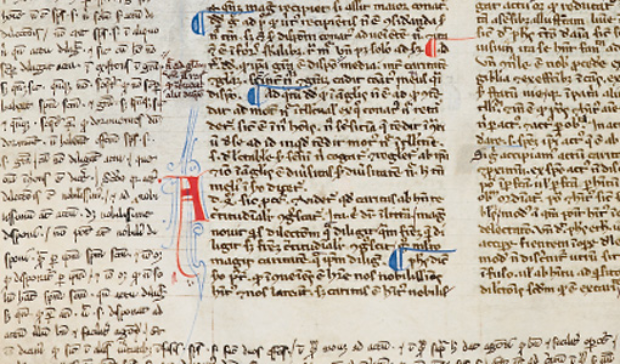When St. Thomas Aquinas died in 1274, his colleagues immediately made catalogues of his many writings. St. Thomas was as orderly in his work as he was in his thinking, and almost all of what he wrote was easily accounted for. But there was a teaser.
Forty years after Aquinas’ death, Tolomeo of Lucca wrote a biography of his illustrious brother Dominican, in which he reported the existence of a work of St. Thomas not mentioned by anyone else. Legends were already growing around the master, but Tolomeo was an especially trustworthy source. He had been a student and friend of St. Thomas at the end of the great teacher’s life, and he said he had seen the work with his own eyes. He also reported that the work was already missing.
What Tolomeo saw was a commentary on Peter Lombard’s Book of Sentences, the standard textbook for the study of theology. To become a professor of theology one was required to write a commentary on this book, discussing the major topics in theology. St. Thomas did this at the beginning of his career while a student at the University of Paris. But Tolomeo reported that St. Thomas commented a second time on the first part of the Book of Sentences, and he did it not at the beginning of his career but in the middle when he was assigned to teach theology in the Roman province of his own Dominican order. He never published this second commentary, but it survived, according to Tolomeo, in a student transcription.
St. Thomas, of course, lived 200 years before the invention of printing; every book had to be copied by hand. In the 13th century, Europeans devised ways to produce books relatively quickly. Key to swift book production was the development of a system of markings and abbreviations, a kind of shorthand, that permitted rapid copying. Few of us spell out “Street” when we address an envelope; we simply write “St.” So it was in the 13th century except that almost all words would in some way be shortened according to a complex system of abbreviations, contractions and signs. As a result, a scribe could not only copy a manuscript quickly, he also could copy down what he heard. Students routinely did this in their university classes, copying down the lectures of the master as delivered. It was just such a transcription of St. Thomas lectures that Tolomeo had seen.
Seven hundred years after the death of St. Thomas, another Dominican, Father Leonard Boyle, announced in a public lecture at the Pontifical Institute of Mediaeval Studies in Toronto that he had found St. Thomas’ lost second commentary on the Book of Sentences.
An Irishman of stunning erudition and refreshing wit, Boyle was a professor at the Pontifical Institute and one of the 20th century’s great scholars of medieval manuscripts. When he announced his discovery during his 1982 lecture, I was a young graduate student in the audience.
The topics in this commentary are central to St. Thomas’ theology: the nature of theology itself, the attributes of God, how we know God, the Trinity, charity.
Boyle was one of my teachers; we had fun, given our shared surname, trying to figure out if we were related, although we never found a link. The morning after his lecture, Boyle was in the kitchen of the Pontifical Institute common room making his morn ing cup of tea, when I commented on his amazing discovery. He asked me if I cared to edit the work for publication with him; he liked the sound of “Boyle and Boyle.” And so began a 15-year collaboration.
The manuscript is in Lincoln College in Oxford. Although it has been in Oxford since the 15th century, the handwriting of the manuscript reveals that it was written in Italy in the 13th century. The medieval manuscripts displayed in museums usually are beautiful works of art, pages of which are reproduced in Christmas cards and prayer books. The manuscripts of university teachers and students are not such works of art but rather the working tools of scholars. The margins often are filled with notes or even other texts. They may not be handsome, but they transmit the intellectual labors of many centuries. Such is this modest Italian manuscript.
The main body of the manuscript is a copy of St. Thomas’ first commentary on the Book of Sentences written in Paris at the beginning of his career. What caught Boyle’s eye in this manuscript was in the margins: an entire second commentary on Peter Lombard, different from the Parisian commentary in the body of the manuscript.
Most of this anonymous commentary had been carefully placed in the margin next to the part of the Parisian commentary treating the same topic. But not all would fit where it belonged; some had been put on blank pages at the beginning of the manuscript with a note indicating where it was to be placed “according to the other lecture of brother Thomas.” These words – “the other lecture of brother Thomas” – written by the man who had copied this second commentary into the margins of St. Thomas’ Parisian commentary, opened Boyle’s eyes to the identity of the marginal commentary.
If the marginal commentary was written by anyone other than St. Thomas, the main Parisian commentary would simply be called “the lecture of brother Thomas.” The “other lecture” only makes sense if the marginal commentary also is a work of St. Thomas.
Boyle realized that the margins of this manuscript contained the lost second commentary of St. Thomas. More evidence of authenticity would follow, but it all started with the thoughtful reading of a note in the margin of a manuscript.
Our edition, first discussed in that kitchen conversation of 1982, would be 24 years in the making. Boyle would leave Toronto in 1985 to become the director of the Vatican Library in Rome. I would finish graduate school, begin work at the College of St. Thomas in the spring of 1990 and start teaching at the new University of St. Thomas that fall. Throughout this time we worked on preparing St. Thomas’ lost work for publication. Much of my own work on the edition was done over the summers, thanks to the generous support of Monsignor Terrence Murphy and his Aquinas Foundation.
Getting a medieval Latin text from manuscript to printed book is a work of several stages. First, I transcribed the Latin as found in the manuscript, expanding the constant contractions and abbreviations. Different words can have the same abbreviation (even in English: is that “St.” short for “Street” or “Saint”?), and squiggles are easily misread, especially when working from microfilm. The transcription must therefore be checked and checked again.
Once we were relatively confident that we had transcribed the Latin as found in the manuscript, I undertook to make it readable by adding modern punctuation, capitalization and paragraphing. Every once in a while, however, the text just simply did not make sense: a word seemed to be missing or the grammar was off. This is the kind of thing that happens when manuscripts are copied by hand. As editors, we fixed these mistakes but in a way that made it clear to the reader that we had intervened.
St. Thomas frequently cited the early Fathers of the church as well as ancient philosophers, especially Aristotle. I spent my first sabbatical year tracking down every one of the 334 citations in the commentary. My task was to make sure each citation was correct (most were) and provide an accurate reference for the modern reader to the cited work. I was able to find all but one.
The topics in this commentary are central to St. Thomas’ theology: the nature of theology itself, the attributes of God, how we know God, the Trinity, charity. It is a feature of St. Thomas’ mind that he was constantly refining his thought, and thus he returned to these central topics over and over again in his writings.
While there are no dramatic changes in St. Thomas’ thinking in this commentary, there are splendidly precise articulations of his thought. We find, for example, a clear presentation of the role of philosophy as an aid to the work of the theologian. Here, too, is one of St. Thomas’ fullest treatments of the Holy Spirit, both as the love that unites the Father and the Son in the Trinity and in its working in creation and the church. Yet again, St. Thomas explains how the gift of charity affects the very powers of the human soul.
Because this work had only recently been discovered, Boyle and I wanted to provide the reader with notes indicating where St. Thomas dealt with the topics in other writings so that the various treatments could be compared. I prepared 226 such notes for our edition.
Boyle was working on the edition when he died in Rome in 1999. I was left to finish the edition on my own, which was published by the Pontifical Institute of Mediaeval Studies in 2006. One of the great privileges of my life was to have worked with Boyle to bring out a new work of one of the most significant thinkers in the history of the Catholic Church. It also was a lot of fun. That the edition ever saw completion was due in great part to the support of the University of St. Thomas, for which I am most grateful.
About the author: John Boyle is a professor in the Theology and Catholic Studies departments.





